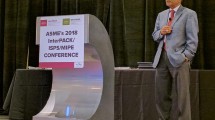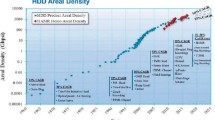Abstract
For those of us who enjoyed the introduction of personal computers in the early 1980’s the inclusion of a state of the art 5-megabyte hard disk drive represented a stunning improvement in computer performance. Only 20 years later, today’s 10-gigabyte drives, which occupy only 1/100pth the volume and sell for 1/4pth the price of these original drives, are commonly found in notebook computers. Since the first viable commercialization of magnetic recording tape in the 1930’s and hard disk drives in the 1950’s the annual areal density growth rate remained reasonably constant at about 25 to 30% per year. However, with the introduction of thin-film hard-disk media and magnetoresistive transducers in the early 1990’s this growth rate increased to about 60% per year, equaling the pace of the growth of computational power of integrated circuits. However, for the past few years the annual growth rate of hard disk recording density has accelerated to over 100 percent per year. Hence, during 2000 we have observed product introductions utilizing 15 gigabits/inp2 and multiple laboratory demonstrations in the 30–50 gigabits/inp2 range. By the end of 2000 products will be available utilizing over 20 gigabit/inp2. The technology, which has enabled this apparent revolution in data storage areal density, is based upon both a comprehensive body of accumulated knowledge and significant discoveries concerning materials, signal processing and device-processing technology. And yet, by both simple and extensive modeling, fundamental physical limits to the maximum achievable areal density have been predicted to be nearly at hand. These predicted limits are based upon basic energy and signal-to-noise arguments associated with the recording media and can only be circumvented if one understands the underlying assumptions and then designs around these issues. The purpose of this paper is to provide an overview of some of these issues, of the state of the art hard disk media technology and to propose methods of extending recording densities beyond these limits.
Access this chapter
Tax calculation will be finalised at checkout
Purchases are for personal use only
Preview
Unable to display preview. Download preview PDF.
Similar content being viewed by others
References
P.-L. Lu, S. Charap, MAG-30, 4230 (1994), S. Charap, P. Lu, Y. He, MAG-33, 978 (1997).
J. C. Mallinson, MAG-5, 182–186 (1969).
L. Thurlings, MAG-16, 507–513 (1980).
R. A. Baugh, E. S. Murdock and B. R. Natarajan, MAG-19,1722 (1983)
N. R. Belk, P. K. George, and G. S. Mowry, MAG-21,1350 (1985).
D. N. Lambeth, W. Yang, H. Gong, D.E. Laughlin, B. Lu, L.-L. Lee, J. Zou, P.S. Harllee, Mater. Res. Soc. Symp. Proc, Vol. 517,181(1998)
J. Daval and D. Randet, MAG-6, 768 (1970).
Y. Matsudaetal, MAG-35, 2640 (1999)
E. N. Abarra, I. Okamoto, and Y. Mizoushita, Intermag 2000, paper AA-06, “Longitudinal Magnetic Recording Media with Thermal Stabilization.”
L.-L. Lee, D. E. Laughlin, L. Fang, and D. N. Lambeth, MAG-30, 3951 (1994) and MAG-31, 2728 (1995).
B. Lu, D.E. Laughlin, D.N. Lambeth, S.Z. Wu, R. Ranjan and G.C. Rauch, J. Appl. Pnys. 85, 4295 (1999).
L. Fang and D. N. Lambeth, Appl. Phys. Lett, 65, 3137 (1994)
J. Zou, Ph.D Thesis, Carnegie Mellon University, May 2000
M. Doerner, et al, Intermag 2000, paper GA-01, “Advance Media on Glass Substrates for 30 Gbits/in2 and Beyond.”
R. M. H. New, R. F. W. Pease and R. L. White, J. Vac. Sci TechnoL B, 12, 3196 (1994)
S. Chou, Proceedings of the IEEE, 85, No.4,652–671, (1997)
E. Mayes, Poster Presentation at “The Magnetic Recording Conference,” 1998.
V. F. Puntes, P. Alivisatos and K. Krishnan, Nato-ASI, Magnetic Storages Systems Beyond 2000, June, 2000
S. Sun, C. B. Murray, D. Weiler, A. Moser, L. Folks, Science 287,1989 (2000)
W. Yang and D. N. Lambeth, MAG-33 (5), 2965 (1997)
A. Nakmura and M. Futamoto, Jpn. J. Appl. Phys., 32, Pt 2, 10A, L1410, (1993)
Author information
Authors and Affiliations
Editor information
Editors and Affiliations
Rights and permissions
Copyright information
© 2001 Springer Science+Business Media Dordrecht
About this chapter
Cite this chapter
Lambeth, D.N. (2001). Modern Hard Disk Media Issues. In: Hadjipanayis, G.C. (eds) Magnetic Storage Systems Beyond 2000. NATO Science Series, vol 41. Springer, Dordrecht. https://doi.org/10.1007/978-94-010-0624-8_3
Download citation
DOI: https://doi.org/10.1007/978-94-010-0624-8_3
Publisher Name: Springer, Dordrecht
Print ISBN: 978-1-4020-0118-5
Online ISBN: 978-94-010-0624-8
eBook Packages: Springer Book Archive




